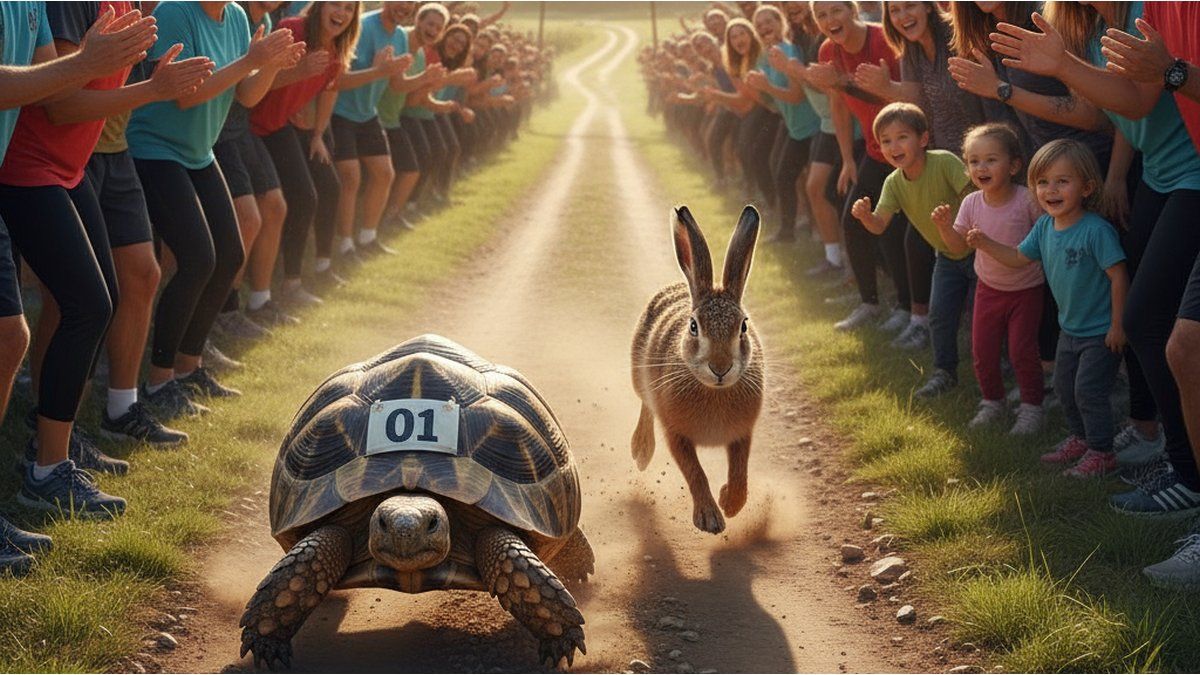We ask for empathy, collaboration and creativity. However, money—and time—mostly goes to short-term efficiencies and, for some time now, to AI. 40% of employers already anticipate reducing staff where AI can automate tasks, and macro-trends project 92 million displaced positions in the coming years —even with positive net job creation—.
In parallel, formal practice time per person falls (13.7 hours in 2024 vs. 17.4 in 2023), which erodes the training of human skills.
We invest in the hare that accelerates, while the tortoise that sustains results—human practice between people—remains underfunded. The question is no longer just who to support, but what are we predicting when we allocate budget: a low-cost sprint or a season with reliable leadership?
If AI is the co-brain, the mature decision is simple: Capex in AI + Opex in human skills. If it really is that simple, what stops us from doing it?
To forecast is to create criteria for the future. Every peso and every hour we spend today is a script of what will be normal tomorrow. Are we using that power to build human capabilities—with AI as the co-brain that powers them—or are we continuing to give it up to the suffocation of everyday life?
The paradox of trust today
Here appears the paradox that we see daily in boards of directors and management meetings: “soul” (empathy, collaboration, creativity) is asked for and, at the same time, cuts are made in the place where that “soul” is trained: practice between people.
A bot can help prepare, summarize, propose variants and even simulate scenarios. What it cannot yet do is reproduce the fertile discomfort of a real conversation where there are silences, nuances, emotional regulation and agreements that change behaviors.
The alchemy of trust between people still happens live. However, many experience that trust with AI and that is a trap in that we do not measure the impact it has on us.
What is gained? What is lost?
That AI runs like a hare is good news if we know why we want it in the race. It gains speed, increases memory, low operational friction and depersonalizes the first analysis when the topic is hot. But if the organization stays there, what impacts the business the most is lost: transfer to day-to-day life. Without practice done by people, feedback remains intentional and agreements are diluted in urgency among some of the examples.
What makes leadership lasting?
What makes the human endure is your ability to learn. That is the pivot that allows leaders – and allowed us to transform like no other species – the ability and capacity to convert experience into judgment, and judgment into consistent action and create culture.
With our learning, we can transform the speed of AI into sustainable results so that they benefit people, who depend on human factors: trust, coordination, focus, quality of decisions to be able to move forward.
Learning becomes operational with three simple and demanding movements:
- Simplify the complex. Before training, we define what specific behavior we want to improve and in what real business scene (not in a fictitious case). Naming the problem well takes 50% of the way.
- Design bridges (Agreements/Bridges/Allies). We establish rules of the game, we practice with demanding peers who do not humiliate and we add observing allies who return effects, not intentions. Known technology comes in here to multiply impact: scripts, scenarios, variants, agreement registration and monitoring.
- Validate with mind and heart. We measure behavioral KPIs (verifiable agreements, task owners, meeting times) and take care of the team’s energy to sustain change. Without energy, there is no habit; Without habit, there is no result.
Let’s go back to the initial question: who are we going to support? If we put everything into the hare, perhaps we will reach the same wall sooner. If we bet only on the turtle, we run the risk of slowness and inefficiency.
The winner is the turtle+hare team. The AI quickly takes us to the correct draft; human learning turns it into consistent behavior that sustains the numbers.
How effective would it be to ask AI, in addition to measuring the productivity of a model, to measure the rate of agreements fulfilled between people at 14 days? Just as a savings is celebrated, is “something” created together with AI that holds a meeting that ends in 45 minutes with clarity of owners and next steps?
Because forecasting is creating criteria for the future, and each budget is a bet on what will be normal tomorrow. If we want fast, reliable organizations, mature investing is not a moral dilemma: it is an operational design.
Capex in AI to run like a hare. Opex in human skills to arrive like a turtle and that between the two they build and sustain the best future for everyone.
The hare runs faster and faster. The human comes when he learns. That is the pivot that is worth financing if we want the human to endure.
Executive Coaching Advisor, educational psychologist and creator of “Fast Pass Way”, a five-step method to help leaders and teams simplify the complex, decide better and achieve sustainable results without burnout. He works with companies and SMEs in LATAM and other markets, integrating the technical-operational, the human and the systemic to accelerate execution with well-being.
Source: Ambito
David William is a talented author who has made a name for himself in the world of writing. He is a professional author who writes on a wide range of topics, from general interest to opinion news. David is currently working as a writer at 24 hours worlds where he brings his unique perspective and in-depth research to his articles, making them both informative and engaging.




